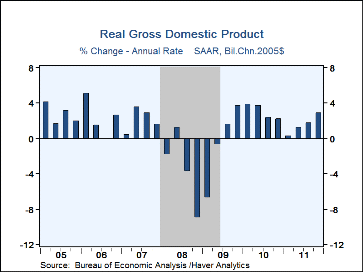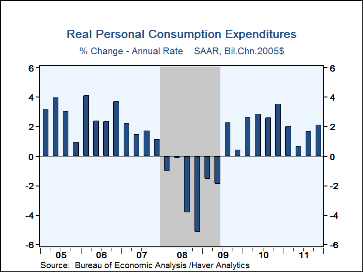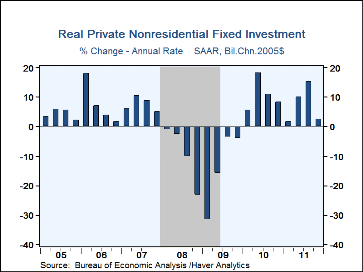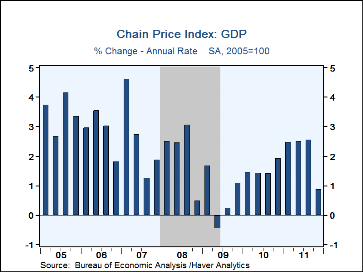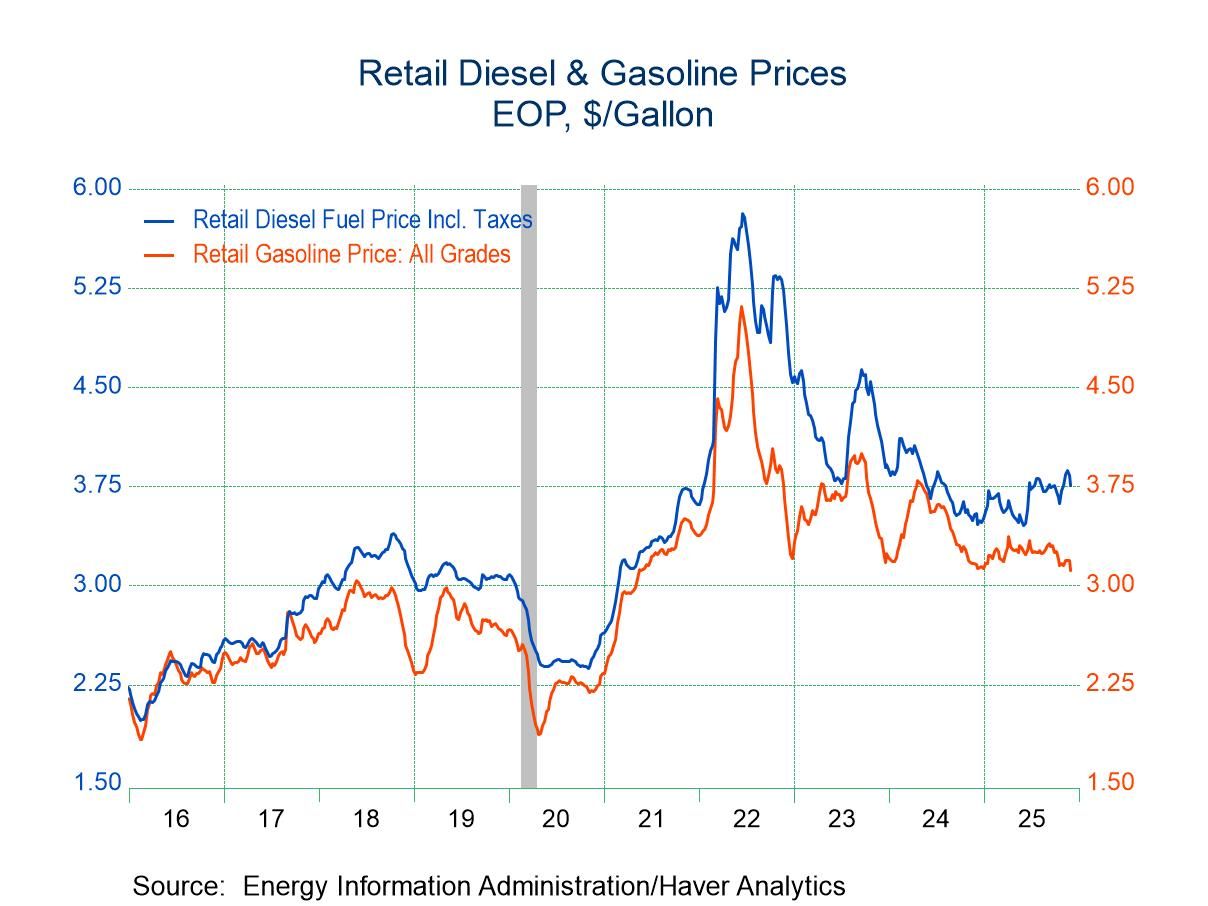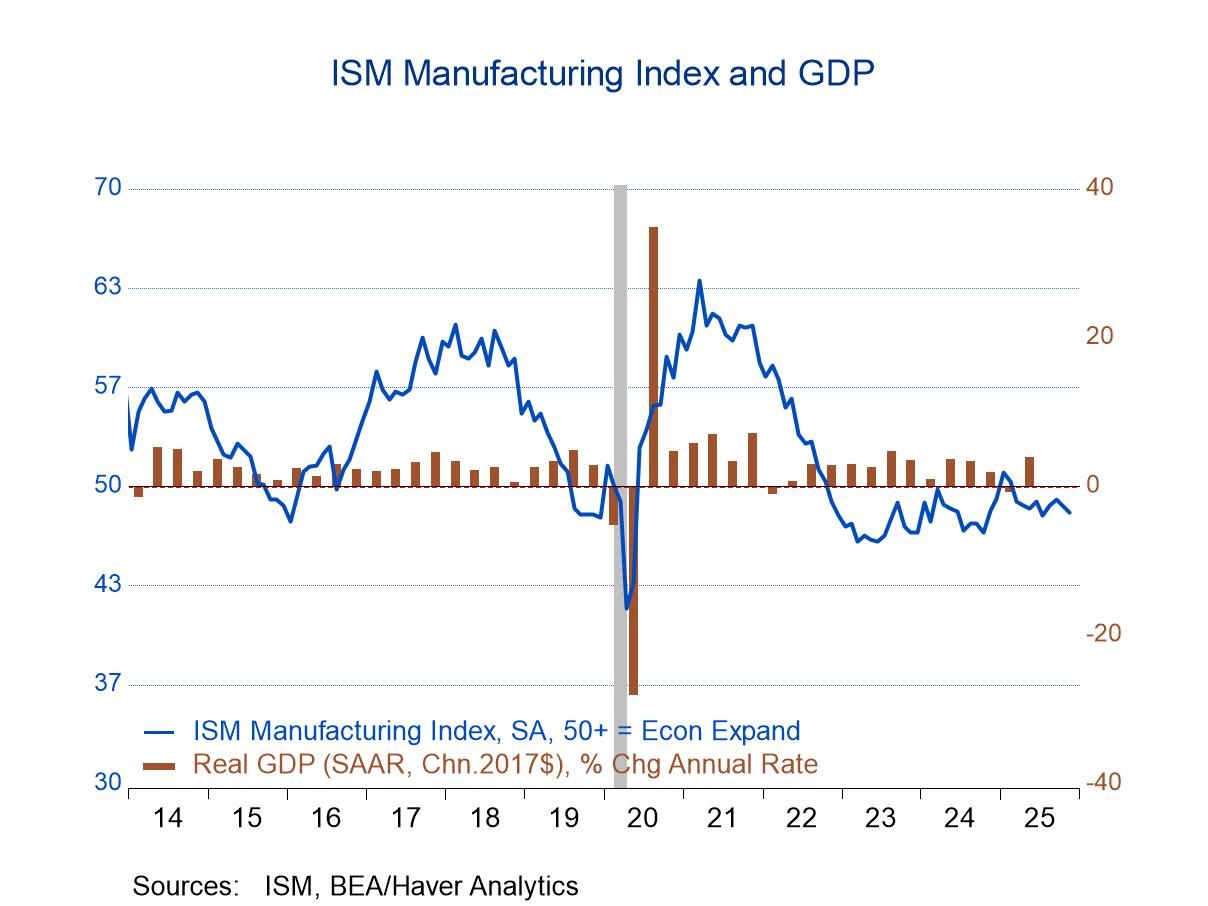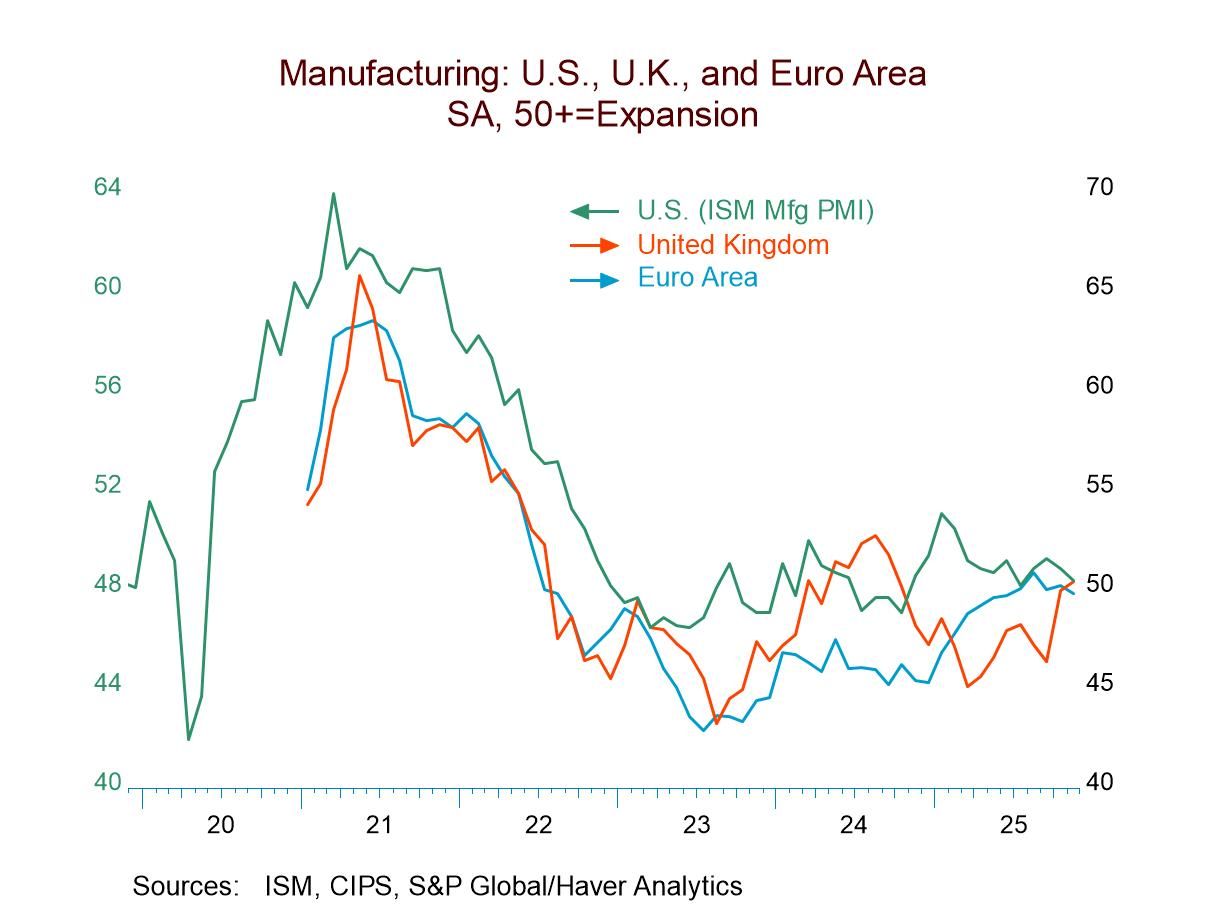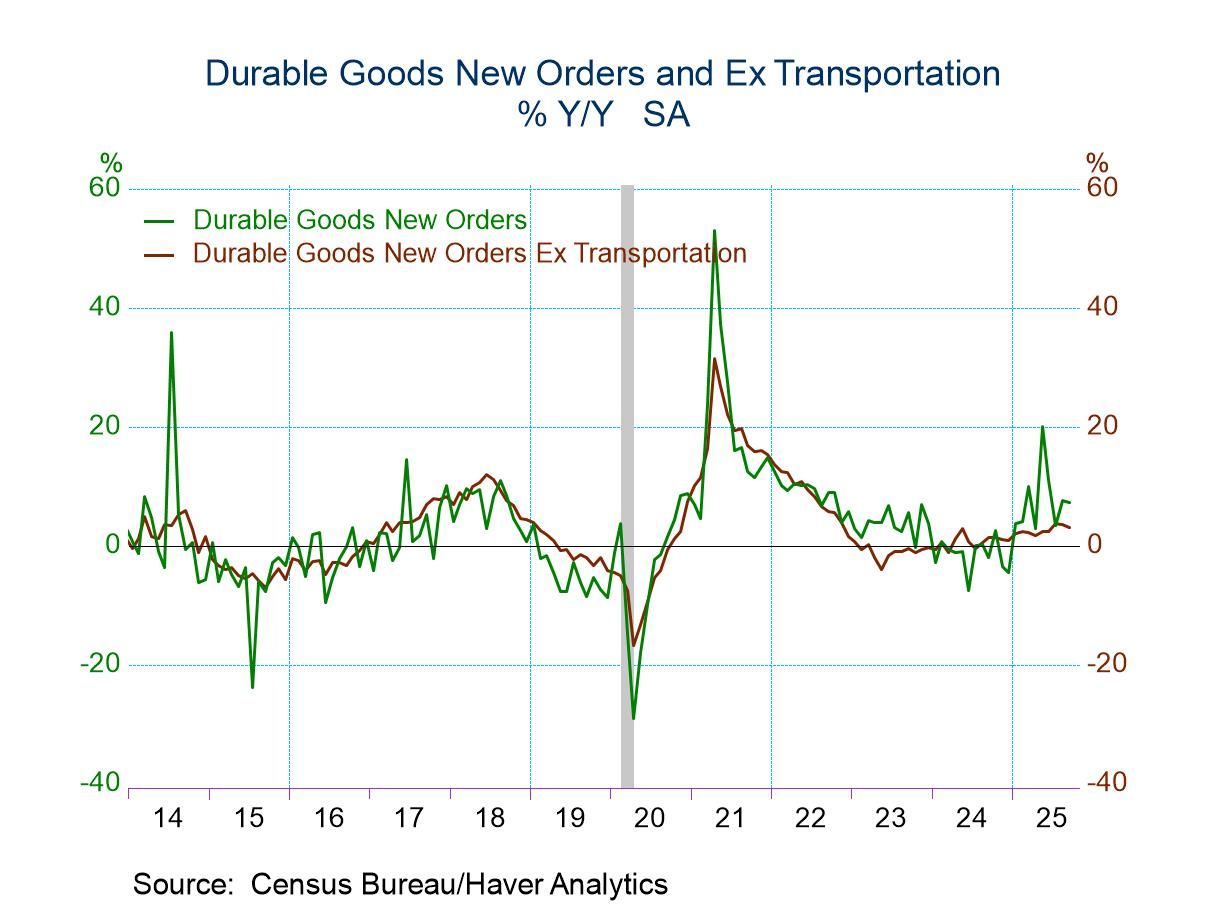 Global| Feb 29 2012
Global| Feb 29 2012U.S. GDP Growth Is Revised Up
by:Tom Moeller
|in:Economy in Brief
Summary
Economic growth last quarter was slightly higher than originally estimated. The Commerce Department indicated that Q4'11 real GDP grew at a 3.0% annual rate, revised from 2.8%. Expectations had been for an unchanged 2.8% rise. Growth [...]
Economic growth last quarter was slightly higher than originally estimated. The Commerce Department indicated that Q4'11 real GDP grew at a 3.0% annual rate, revised from 2.8%. Expectations had been for an unchanged 2.8% rise. Growth last quarter remained the strongest since Q2'10. An unrevised 1.9 percentage point contribution to growth from faster inventory accumulation remained the main impetus for Q4 growth. That contribution followed a subtraction from growth during three of the prior four quarters. Foreign trade subtracted an unrevised 0.1 percentage points from growth as exports rose at a 4.3% rate (5.1% y/y) and imports rose 3.8% (3.6% y/y).
Domestic final sales growth was revised minimally higher to 1.1% (1.5% y/y), mostly due to a raised estimate of growth in business fixed investment to 2.8% (7.6% y/y). Growth in personal consumption expenditures of 2.1% (1.7% y/y) was little-changed and still the weakest gain since Q1'10. Residential investment growth also was improved to 11.5% (3.5% y/y) and was the strongest since Q2'10 when growth was fueled by a government subsidy to home buyers. The decline in government spending was little-changed at -4.4% (-2.8% y/y).
Price inflation as measured by the chain-type price index was raised to 0.9% from 0.4% but was still the weakest since Q3'09. The PCE price index rose at a modest 1.2% rate (2.7% y/y). However, full-year growth in the index of 2.5% was the strongest since 2008 due to strength in food and energy prices.
The latest GDP figures can be found in Haver's USECON and USNA databases; USNA contains basically all of the Bureau of Economic Analysis' detail on the national accounts, including the new integrated economics accounts and the recently added GDP data for U.S. Territories. The Consensus estimates can be found in AS1REPNA.
Today's testimony by Fed Chairman Ben S. Bernanke can be found here.
| Chained 2005 $, % AR | Q4'11 (2nd) | Q4'11 (Adv) | Q3'11 | Q2'11 | Q4'11 Y/Y |
2011 | 2010 | 2009 |
|---|---|---|---|---|---|---|---|---|
| Gross Domestic Product | 3.0 | 2.8 | 1.8 | 1.3 | 1.6 | 1.7 | 3.0 | -3.5 |
| Inventory Effect | 1.9 | 1.9 | -1.4 | -0.3 | 0.1 | -0.2 | 1.6 | -0.9 |
| Final Sales | 1.1 | 0.8 | 3.2 | 1.6 | 1.5 | 1.9 | 1.4 | -2.6 |
| Foreign Trade Effect | -0.1 | -0.1 | 0.4 | 0.2 | 0.1 | 0.1 | -0.4 | 1.0 |
| Domestic Final Sales | 1.1 | 0.9 | 2.7 | 1.3 | 1.4 | 1.8 | 1.8 | -3.6 |
| Demand Components | ||||||||
| Personal Consumption | 2.1 | 2.0 | 1.7 | 0.7 | 1.7 | 2.2 | 2.0 | -1.9 |
| Business Fixed Investment | 2.8 | 1.7 | 15.7 | 10.3 | 7.6 | 8.7 | 4.4 | -17.9 |
| Residential Investment | 11.5 | 10.9 | 1.2 | 4.2 | 3.5 | -1.4 | -4.3 | -22.2 |
| Government Spending | -4.4 | -4.6 | -0.1 | -0.9 | -2.8 | -2.1 | 0.7 | 1.7 |
| Chain-Type Price Index | ||||||||
| GDP | 0.9 | 0.4 | 2.6 | 2.5 | 2.1 | 2.1 | 1.2 | 1.1 |
| Final Sales of Domestic Product | 0.9 | 0.4 | 2.6 | 2.5 | 2.1 | 2.1 | 1.2 | 1.0 |
| Final Sales to Domestic Purchasers | 1.1 | 0.8 | 2.0 | 3.4 | 2.6 | 2.5 | 1.5 | -0.1 |
Tom Moeller
AuthorMore in Author Profile »Prior to joining Haver Analytics in 2000, Mr. Moeller worked as the Economist at Chancellor Capital Management from 1985 to 1999. There, he developed comprehensive economic forecasts and interpreted economic data for equity and fixed income portfolio managers. Also at Chancellor, Mr. Moeller worked as an equity analyst and was responsible for researching and rating companies in the economically sensitive automobile and housing industries for investment in Chancellor’s equity portfolio. Prior to joining Chancellor, Mr. Moeller was an Economist at Citibank from 1979 to 1984. He also analyzed pricing behavior in the metals industry for the Council on Wage and Price Stability in Washington, D.C. In 1999, Mr. Moeller received the award for most accurate forecast from the Forecasters' Club of New York. From 1990 to 1992 he was President of the New York Association for Business Economists. Mr. Moeller earned an M.B.A. in Finance from Fordham University, where he graduated in 1987. He holds a Bachelor of Arts in Economics from George Washington University.


